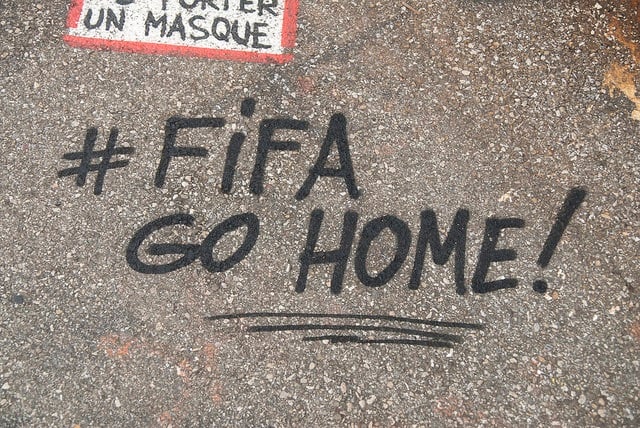Galleries
Brazilian Street Art Reflects Divide Over FIFA World Cup


Eileen Kinsella

A detailed account in the Washington Post explores (once again) the divided feelings throughout Brazil about its role as host country for the 2014 FIFA World Cup, noting that the controversial and costly event has given street artists ample inspiration. “While some murals celebrate Brazil’s passionate love affair with soccer, other buildings are plastered with protest art, often depicting themes of greed and deriding a nation’s misplaced priorities,” Rick Maese and Dom Phillips write. In one mural, a favela child looks at a gleaming but far-off stadium, while another depicts a businessman and an athlete kicking around a ball-shaped bag of money.
The story features interviews with several graffiti artists. Paulo Ito, whose image of a starving, crying child seated in front of a plate with a soccer ball on it went viral recently, tells the Post, “It is a political thinking in a certain way. Not in all these works; others are more poetic than political.” Another of his works shows the tournament mascot, an armadillo named Fuelco, standing in front of a stadium and telling a family to scatter.
The piece also notes that, unlike in other countries, street art is pretty much accepted as being part of the urban ecosystem in Brazil. “Grafitti provides the dominant visual in almost every corner of the city, whether it’s colorful, detailed murals or hastily painted signatures of street gang members,” the writers explain. In São Paulo, city officials gave 70 street artists a two-and-a-half mile wall that is now a “long ribbon of graffiti, all of it celebrating soccer, Brazil and the World Cup, reportedly carrying a price tag of $1.3 million” (it’s unclear what is meant by “price tag.” The cost of relinquishing the wall? Materials involved?).
Another street artist and gallery owner, Baixo Ribeiro, estimates there are 3,000 serious street artists in São Paulo alone. Ribeiro says the World Cup prompted a much-needed dialogue about social ills that have dogged Brazil for years. Tellingly, the story notes, the country’s four-year presidential elections cycle runs parallel with the World Cup cycle.